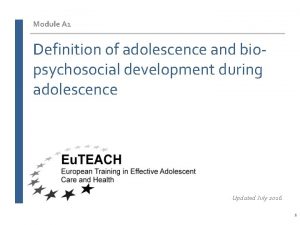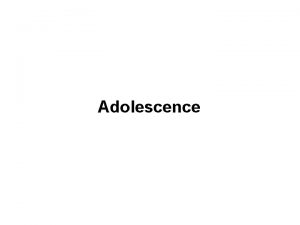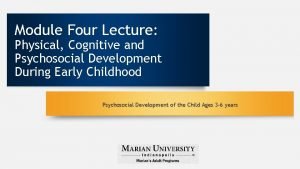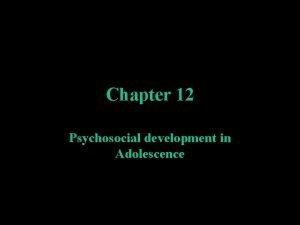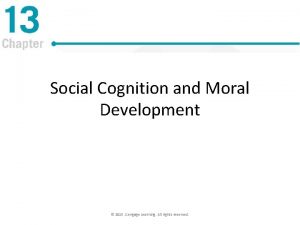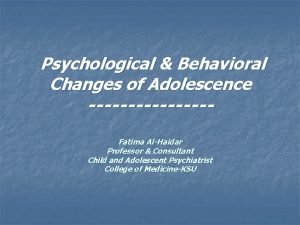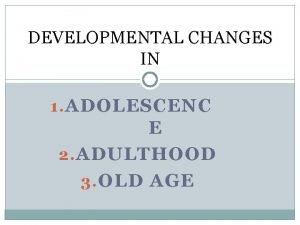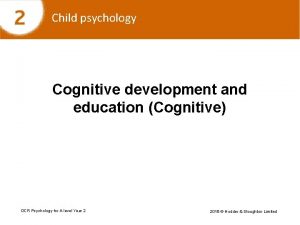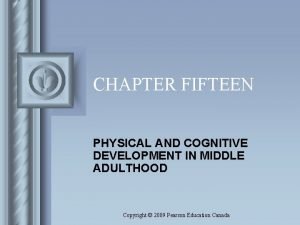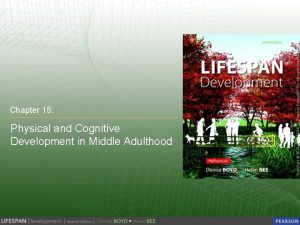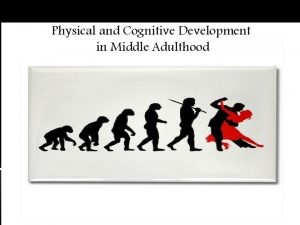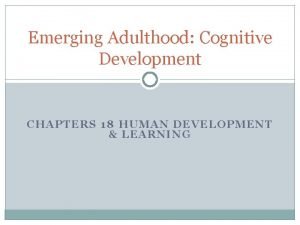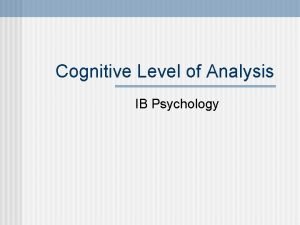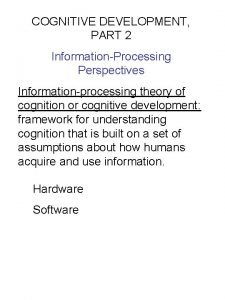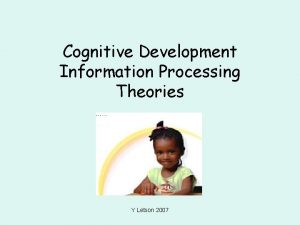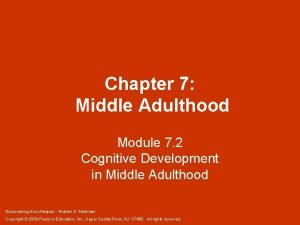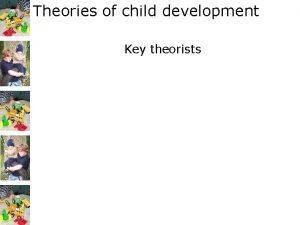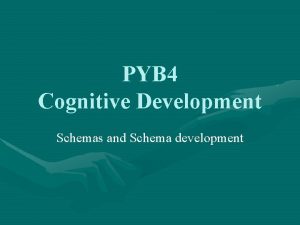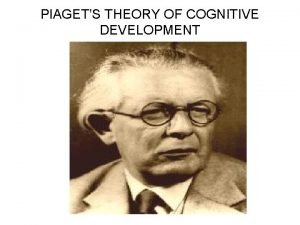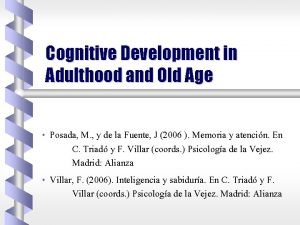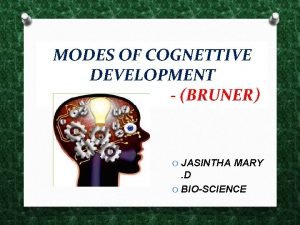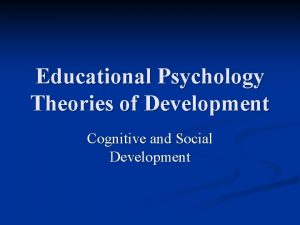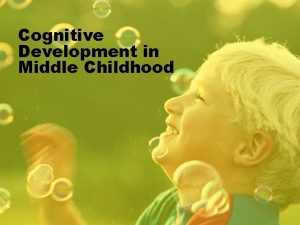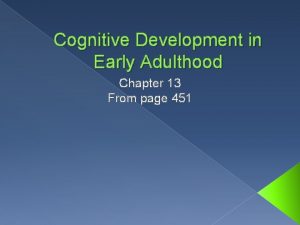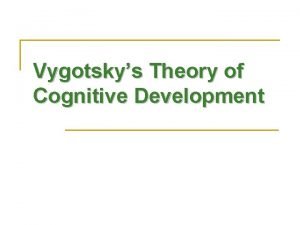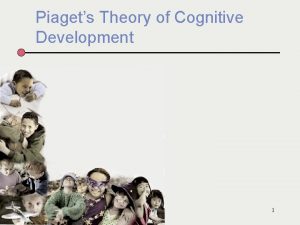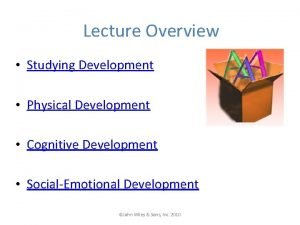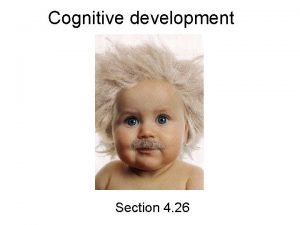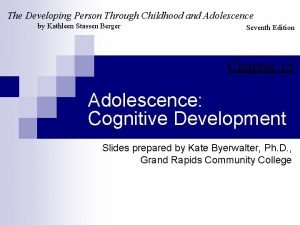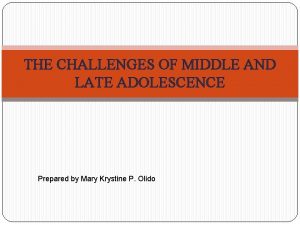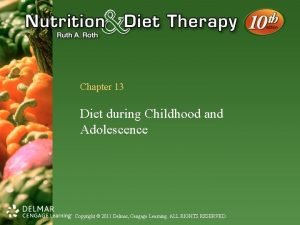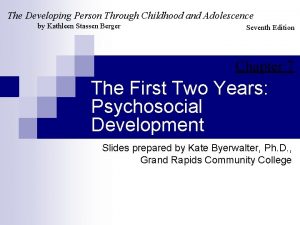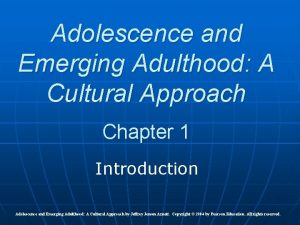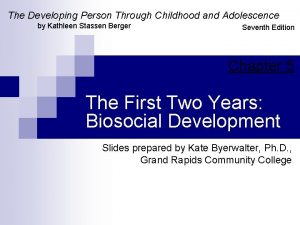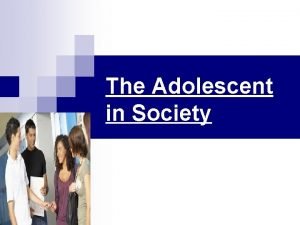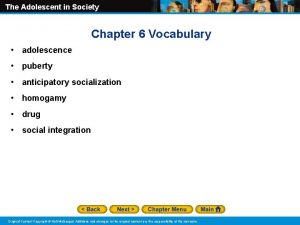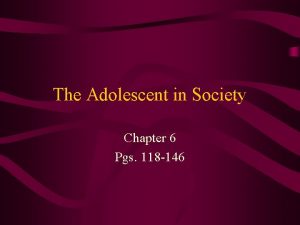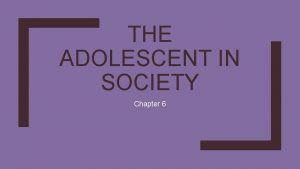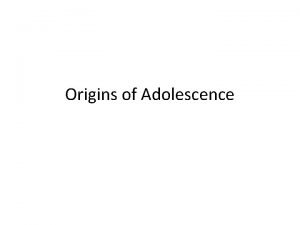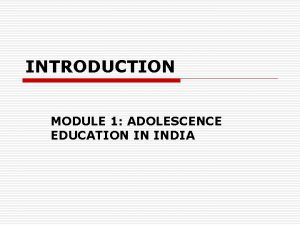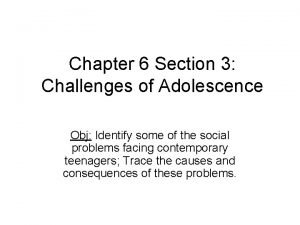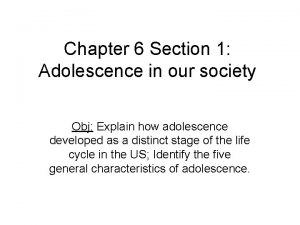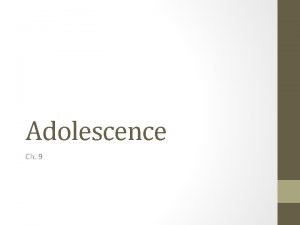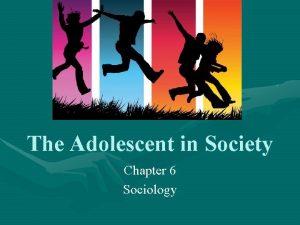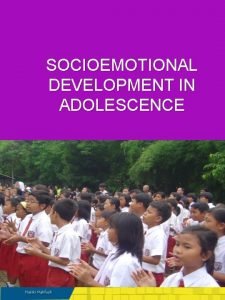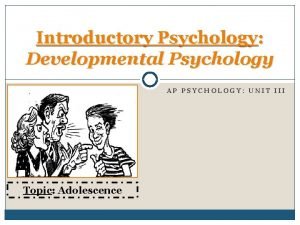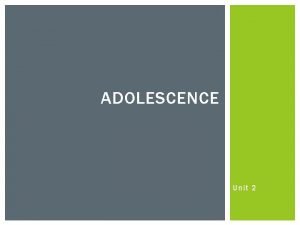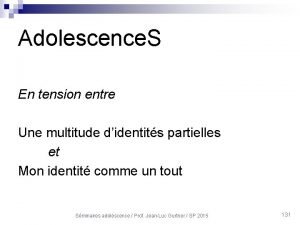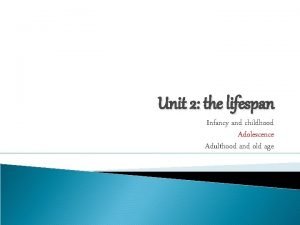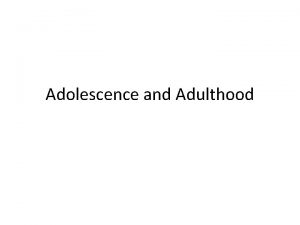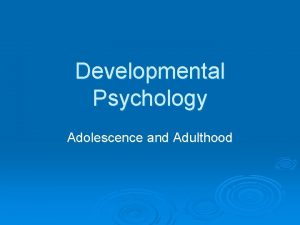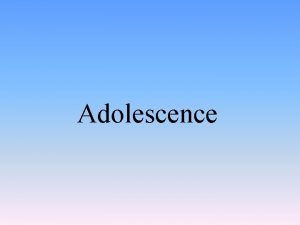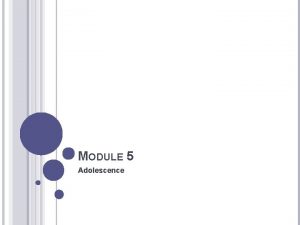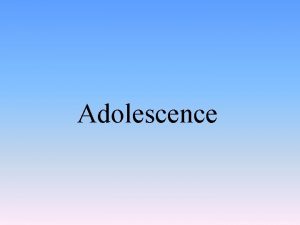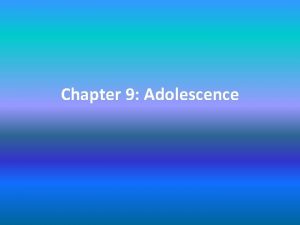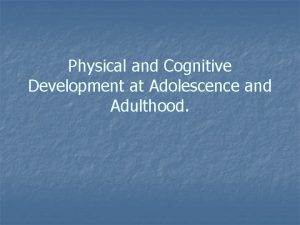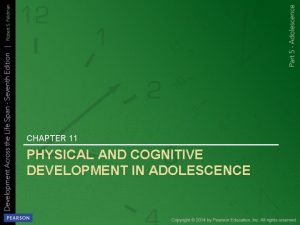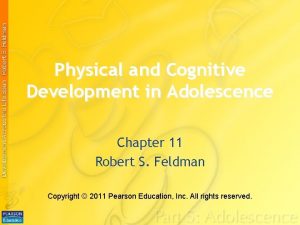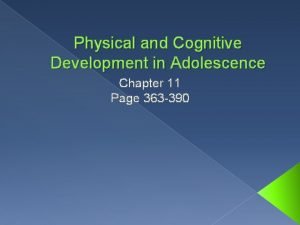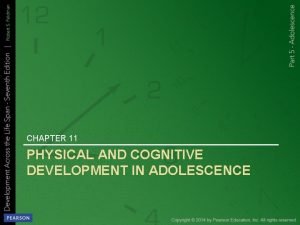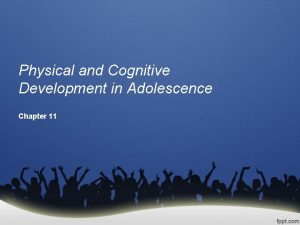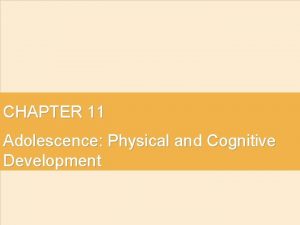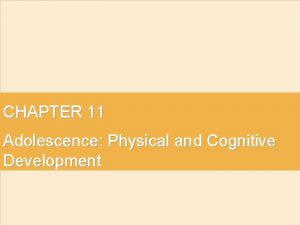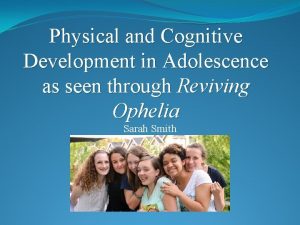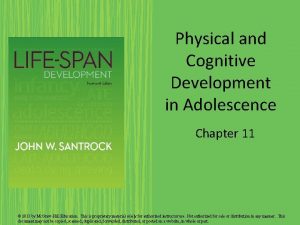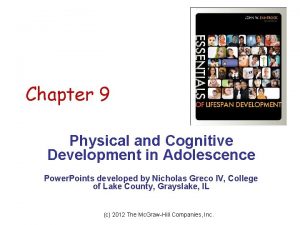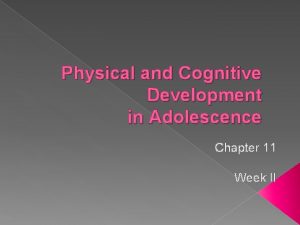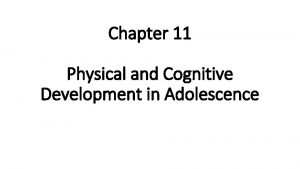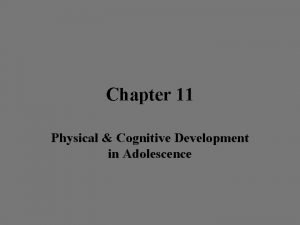Physical and Cognitive Development in Adolescence Physical and














































































- Slides: 78

Physical and Cognitive Development in Adolescence

Physical and Cognitive Development in Adolescence Ø Discuss the nature of adolescence. Ø Describe pubertal changes and adolescent sexuality. Ø Identify adolescent problems in substance use (alcohol and smoking) and abuse, sexual harassment eating disorders and health Ø Explain cognitive changes in adolescence. Ø Summarize some key aspects of how schools influence adolescent development.

The Nature of Adolescence DEPENDS RELATIONSHIP WITH PARENTS BIOLOGICAL GENETIC ENVIRONMENTAL ADOLESCENCE OTHER

The Nature of Adolescence contd. 1. Genetic, biological, environmental and social factors interact in teen development. 2. Relationships with parents take a different form. 3. Dating occurs for the first time.

The Nature of Adolescence cont. . 1. Thoughts are more abstract and idealistic. 2. Biological changes trigger a heightened interest in body image. 3. Most adolescents have a positive selfconcept(self oriented) and positive relationships with others.

What is Puberty? o Puberty is a period of rapid physical maturation involving hormonal and bodily changes that occur primarily during early adolescence.

Pubertal Changes-(bodily changes) o The onset of puberty is determined by: – Nutrition – Health – Heredity – Body Mass o Puberty is not a single, sudden event. o Pinpointing its beginning and its end is difficult.

Hormonal Changes o Hormones-Powerful chemical substances secreted by the endocrine glands and carried through the body by the bloodstream. Testosterone - hormone associated in boys with the development of genitals, an increase in height, and a change in voice

Hormonal Changes cntd. Estradiol -Active form of estrogen -hormone associated in girls with breast, uterine, and skeletal development

Where do these hormones come from?

Endocrine system.

The Endocrine System ○ Hypothalamus - a structure in the higher portion of the brain that monitors eating, drinking, and sex

Pituitary gland ○ An endocrine gland that controls growth and regulates other glands.

Gonads The sex glands Testes -in males Ovaries - in females

Gonadotropin Hormones that stimulate the testes or ovaries

The Endocrine System cont. The endocrine system’s role in puberty involves interaction of the hypothalamus, pituitary gland, and gonads. o The pituitary gland also interacts with the thyroid gland to enhance growth and skeletal maturation. o The concentrations of certain hormones increase dramatically during adolescence. o Hormones contribute to both physical and psychological development. o

Height and Weight Growth spurt occurs about 2 years earlier for girls. • Mean beginning of the growth spurt - age 9 for girls, age 11 for boys. .

Height and Weight cntd. • Peak rate of pubertal change - age 11. 5 for girls, age 13. 5 for boys. • Increase in height - about 8, 9 cm per year for girls, about 10, 12 cm for boys. • The rate at which adolescents gain weight follows approximately the same timetable as height

Sexual Maturation in Boys Secondary sexual characteristics Ø Increase in penis and testicle size Ø Appearance of straight pubic hair 1 st Ø First ejaculation Ø Onset of maximum growth Ø Growth of hair in armpits Ø More detectable voice change Ø Growth of facial hair


Sexual Maturation in Girls • Breasts enlargement • Pubic hair appears • Hair appears in the armpits • Growth in height ………

Sexual Maturation in Girls cntd. . • Hips become wider than shoulders • First menstruation comes rather late in puberty • Menstrual cycles are often highly irregular • Some girls aren’t fertile until 2 years later

Body Image A person's feelings of the nature of beauty, art, and taste and sexual attractiveness of his or her own body • Adolescents are preoccupied with their bodies and develop individual images of what their bodies are like • Adolescents are more dissatisfied with their bodies during puberty than in late adolescence. • Girls are less happy with their bodies and have more negative body images than boys throughout puberty. • As pubertal change proceeds, girls often become more dissatisfied with their bodies due to the increase in body fat, while boys become more satisfied due to the increase in muscle mass,

Early and Late Maturation in Boys • Recent research confirms that during adolescence, it is advantageous to be an early maturing rather than late-maturing boy. • Early maturing boys appear to perceive themselves more positively and have more successful peer relations than their latematuring counterparts.

Early and Late Maturation in Girls o Recent findings suggest that early-maturing girls experience more problems in school. o They also experience more independence and popularity with boys. o In sixth grade, earlymaturing girls show greater satisfaction with their figures, but by tenth grade, late-maturing girls are more satisfied. ………….

Adolescent Sexuality o Adolescence is a time of sexual exploration and experimentation. o Adolescence is a bridge between the asexual child and the sexual adult. o Sexual development and interest are normal aspects of adolescent development. o The majority of adolescents have healthy sexual attitudes and engage in sexual practices that will not compromise their development.

Developing a Sexual Identity �An adolescent’s sexual identity involves: Learning to managing sexual feelings Developing new forms of intimacy (closeness) Learning the skills to regulate sexual behavior to avoid undesirable consequences

The Progression of Adolescent Sexual Behaviors �Adolescents engage in a consistent progression of sexual behaviors: Necking Petting Intercourse/Oral sex

�Eight in 10 girls are virgins at age 15. �Seven in 10 boys are virgins at age 15. �The probability that adolescents will have sexual intercourse increases steadily with age.

Risk Factors for Sexual Problems �Adolescents who engage in sex before age 16 are the least effective users of contraception. �They are also at risk for unintended pregnancy and sexually transmitted diseases (STD). �Early sexuality is also linked with excessive drinking and drug use.

Contraceptive Use � Two kinds of risks that youth encounter: unintended/unwanted pregnancy sexually transmitted diseases � A sexually active adolescent who does not use contraception has a 90% chance of pregnancy within 1 year. � Both of these risks can be reduced significantly if contraception is used. � Adolescents are increasing contraceptive use, yet some still do not use contraceptives or use them inconsistently

Sexually Transmitted Diseases �Sexually transmitted diseases (STDs) are contracted primarily through sexual contact, which is not limited to sexual intercourse. Oral-genital and anal-genital contact also can be involved in STDs. �AIDS, syphilys and gonorrhea are more common among adolescents than young adults.

Consequences of Adolescent Pregnancy � Adolescent pregnancy creates health risks for both the offspring and the mother. � Infants born to teen mothers are more likely to have: low birth weights neurological problems childhood illness � Adolescent mothers often drop out of school. � Teen mothers often have a low-income backgrounds

Substance Use and Abuse �Alcohol �Cigarette Smoking �The Roles of Development, Parents, and Peers

Alcohol � Alcohol is the drug most widely used by adolescents in our society. Alcoholism is the third leading killer in the world. Alcohol use by high school seniors has gradually declined. � Data from college students show little drop in alcohol use and an increase in heavy drinking …………. .

Cigarette Smoking � Cigarette Smoking Begins primarily during childhood and adolescence. A study found that once young adolescents begin smoking, the addictive properties of nicotine make it extremely difficult for them to stop. Approximately one-third of youth are active smokers at the end of high school. �The early age of onset of smoking is more important in predicting genetic damage than how much individuals smoke.

The Roles of Development, Parents, and Peers

The Roles of Development, Parents, and Peers �Drug use in childhood or early adolescence has more detrimental long-term effects on the development of responsible, competent behavior than when drug use occurs in late adolescence. �Positive relationships with parents and others are important in reducing adolescents’ drug use. �Adolescents are most likely to take drugs when both of their parents take drugs and when their peers take drugs.

Eating Problems and Disorders

ANOREXIA NERVOSA � � � An eating disorder that involves the relentless pursuit of thinness through starvation; can lead to death. Weigh less than 85% of what is considered normal. Intense fear of gaining weight, which does not dissipate with weight loss. Distorted image of their body shape and constantly weigh themselves. Most are White adolescent or young adult females from well-educated, middle and upper income families. Set high standards and stress at not reaching them. BULIMIA NERVOSA � � � An eating disorder in which the individual consistently follows a binge-and-purge eating pattern. Purging is accomplished through self-inducing vomiting or use of a laxative. Most bulimics are females in their late teens or early twenties. Most bulimics are preoccupied with food, have a strong fear of becoming overweight, and are depressed or anxious. Unlike anorexia, bingeing and purging occurs within a normal weight range and is difficult to detect.

Adolescent Health � Many factors linked to poor health habits and early death in the adult years begin in adolescence � Goals are to reduce health-compromising behavior and increase health-enhancing behaviors. � Leading Causes of Death in Adolescence Accidents - most involve automobiles, due to risky driving habits and driving under the influence of alcohol or drugs. Suicide - accounts for 6% of the deaths in the 10 -14 age group, and 12% of deaths in the 15 -19 age group. Homicide


Piaget’s Theory �Adolescent thought is at the formal operational stage. �Thought is more abstract, characterized by: verbal problem-solving ability increased tendency to think about thought itself thought is full of idealism and possibilities thought is more logical hypothetical-deductive reasoning

Hypothetical-Deductive Reasoning � Adolescents have the cognitive ability to develop hypotheses, or best guesses, about ways to solve problems, such as an algebraic equation. They then systematically deduce, or conclude, which is the best path to follow in solving the equation.

Adolescent Egocentrism �The heightened self-consciousness of adolescents, reflected in their belief that others are as interested in them as they themselves are, and in their sense of personal uniqueness. (over preoccupied with their own internal world) �Dissected into two types of social thinking: imaginary audience personal fable

�The Imaginary Audience � An individual imagines and believes that multitudes of people are enthusiastically listening to or watching him or her � Involves attention-getting behavior—the attempt to be noticed, visible, and “on stage. ” � The Personal Fable � An adolescent’s sense of uniqueness and invulnerability. � Adolescents feel that no one can understand how they really feel. (A person might believe that they are the only one who can experience whatever feelings of joy, horror, misery, or confusion they might encounter) � Personal fables frequently show up in adolescent diaries.

Information Processing �Decision Making �Critical Thinking

Decision Making � Adolescence is a time of increased decision making. � Compared to children, young adolescents are more likely to: generate options examine a situation from a variety of perspectives anticipate the consequences of decisions consider the credibility of sources. � Parents should involve adolescents in appropriate decision-making activities

Critical Thinking � A solid basis of fundamental skills is necessary for the development of critical thinking skills. � Recent studies have shown critical thinking increases with age, but still only occurs less than half the time with high school juniors � Cognitive changes that allow improved critical thinking are: increased speed and capacity of information processing more breadth of content knowledge in a variety of areas increased ability to construct new knowledge combinations


The Transition to Middle or Junior High School �This transition can be stressful. �Many changes are taking place in the individual, in the family, and in school simultaneously. �Changes can be both positive and negative. �Students experience the “top-dog phenomenon, ” moving from top position in elementary school (oldest, biggest, most powerful) to lowest position in middle or junior high school (youngest, smallest, and least powerful).

Difficult Changes in the Transition to Middle School �Puberty and related concerns about body image �Emergence of some formal operational thought �Changes in social cognition �Increased responsibility and independence �Decreased dependency on parents �Change from small contained classrooms to larger, more impersonal school structure �Increased focus on achievement and performance and their assessment

Positive Changes in the Transition to Middle School �Students are more likely to feel grown up. �They have more subjects from which to select. �They have more opportunities to spend time with peers and to locate compatible friends. �They enjoy increased independence from direct parental monitoring. �They may be more challenged intellectually by academic work

Effective Schools for Young Adolescents � Develop smaller “communities” or “houses” to lessen the impersonal nature of large middle schools. � Lower student-to-counselor ratios to 10 -to-1. � Involve parents and community leaders. � Develop curricula that produce students who are literate, understand the sciences, and have a sense of health, ethics, and citizenship. � Have teachers team teach in more flexibly designed curriculum that integrates several subjects. � Have in-school health and fitness programs.

High School �High School Dropouts �Toward Effective High Schools

High School Dropouts �Many do not have the skills that will allow them to advance in the work world. �Students drop out of school due to: school-related reasons (dislike or being expelled) economic reasons personal reasons (pregnancy/marriage in females) �In the last half of the 20 th century, high school drop out rates have declined overall.

Toward Effective High Schools �More support is needed to enable students to graduate from high school with skills needed to succeed. �High schools need to have higher expectations for student achievement. �At the middle and secondary school levels, every student needs strong, positive connections with adults as they explore education and work options

Service Learning �A form of education that promotes social responsibility and service to the community. �An important goal is for students to become less self-centered and more motivated to help others. �It takes education out into the community. �Required community service has increased in high schools.

Socioemotional Development in Adolescence

Self-Esteem �Self-Esteem is the overall way we evaluate ourselves Girls’ self-esteem tends to decline during adolescence, while boys’ self-esteem increases ▪ Girls’ negative body image during pubertal change ▪ Greater interest young adolescent girls take in social relationships ▪ Gender differences may be exaggerated Low self-esteem in adolescence is associated with: ▪ Poorer mental and physical health ▪ Worse economic prospects ▪ Higher levels of criminal behavior

Depression and Suicide � Depression is more likely to occur in adolescence than childhood Linear increase from 15 to 22 years of age Earlier onset is linked with more negative outcomes � Depression is consistently higher in girls and women Females tend to ruminate More negative body image Females face more discrimination than males � Family factors play a role Having a depressed parent Emotionally unavailable parents High marital conflict Parents with financial problems

Depression and Suicide � Suicide is the 3 rd leading cause of death in 10 - to 19 -year- olds � Far more adolescents contemplate or attempt it unsuccessfully than actually commit it � Females are more likely to attempt suicide, but males are more likely to succeed � Lesbian and gay male adolescents are only slightly more likely than heterosexual adolescents to commit suicide

Approximate Age Psycho Social Crisis Significant Relationship Existential Question Examples 0 -2 years Basic Trust vs. Mistrust Mother Can I Trust The World? Feeding, Abandonment 2 -4 years Autonomy vs. Parents Shame and Doubt Is It Ok To Be Me? Toilet Training, Clothing Themselves 4 -5 years Initiative vs. Guilt Family Is It Ok For Me To Do, Move and Act? Exploring, Using Tools or Making Art 5 -12 years Industry vs. Inferiority Neighbors, School Can I Make It In The World School, Sports Of People And Things? Identity vs. Role Confusion Intimacy vs. Isolation Generativity vs. Stagnation Peers, Role Model Friends, Partners Household, Workmates Ego Integrity vs. Despair Mankind, My Kind 13 -19 years 20 -24 years 25 -64 years 65 -death Who Am I? What Can I Be? Social Relationships Can I Love? Romantic Relationships Can I Make My Life Count? Work, Parenthood Is It Ok To Have Been Me? Reflection on Life

Identity � Erikson’s Identity versus Identity Confusion: Who Am I? What Can I Be? Psychosocial Moratorium: the gap between childhood security and adult autonomy ▪ Adolescents are generally free to try out different identities and choose what is right for them Adolescents who resolve the conflict emerge with a refreshing, acceptable sense of self Adolescents who do not successfully resolve the conflict suffer identity confusion ▪ Withdrawal and isolation

Identity (James Marcia) � Four statuses of identity based on crisis or commitment ◦ Crisis: a period of identity development during which the individual is exploring alternatives ◦ Commitment: a personal investment in identity � Diffusion: individuals who have not yet experienced a crisis or made any commitments � Foreclosure: individuals who have made a commitment but not experienced a crisis � Moratorium: individuals who are in the midst of a crisis but whose commitments are absent or weak � Achievement: individuals who have undergone a crisis and made a commitment


Identity �Key changes in identity are more likely to take place in emerging adulthood than in adolescence �Developing a positive identity requires considerable self-discipline and planning �Identity does not remain stable throughout life “MAMA”: repeated cycles of moratorium to achievement

Families �Role of Attachment: ◦ Securely attached adolescents are less likely to engage in problem behaviors such as juvenile delinquency (youth crime) and drug abuse ◦ Securely attached adolescents have better peer relations �Balancing Freedom and Control: ◦ Adolescents still need to stay connected to families ◦ Parents who play an active role in monitoring and guiding adolescents’ development are more likely to have adolescents with positive peer relations and lower drug use

Families �Parent–Adolescent Conflict: Parent–adolescent conflict increases in early adolescence ▪ Conflict typically involves everyday events of family life Disagreements may serve a positive developmental function ▪ Conflicts facilitate the adolescent’s transition from being dependent to becoming autonomous About one in five families engage in prolonged, intense, repeated, unhealthy conflict ▪ Associated with various adolescent problems

Peers � Peer Relationships: ◦ Most teens prefer a smaller number of peer contacts and more intimacy ◦ Friends become increasingly important in meeting social needs during adolescence ◦ Teens with superficial or no friendships tend to be lonely and have lower self-esteem ◦ Characteristics of friends have an important influence �Friends’ grade-point average is a consistent predictor of positive school achievement

Peers � Peer Pressure: the influence exerted by a peer group Young adolescents conform more to peer standards than children do ▪ Peaks about 8 th and 9 th grade ▪ 14 to 18 years of age is an especially important time for developing the ability to stand up for one’s beliefs U. S. adolescents are more likely than Japanese adolescents to put peer pressure on their peers to resist parental influence � Dating: Adolescents who date are more likely to be accepted by peers and be perceived as more physically attractive Dating and romantic relationships at an unusually early age have been linked with several problems ▪ School-related problems & lower grades ▪ Delinquency ▪ Substance use

Culture Peers: Some cultures give peers a stronger role in adolescence than others ▪ In western nations, peers are prominent in adolescents’ lives ▪ In other regions, peer relations are restricted (especially for girls)

Juvenile Delinquency � Juvenile Delinquent: an adolescent who breaks the law or engages in behavior that is considered illegal Broad concept that includes many actions, from littering to murder At least 2% of all youth are involved in juvenile court cases More likely to be committed by males, but involvement by females is increasing Property offenses are committed more than any other crime

Juvenile Delinquency � Should an adolescent who commits a crime be charged as an adult? One study demonstrated that trying adolescent offenders as adults increased their crime rate � Early onset (before age 11) antisocial behavior is associated with more negative outcomes than late onset antisocial behavior More likely to persist into adulthood More mental health and relationship problems

Juvenile Delinquency Causes of Delinquency: Heredity Identity problems Community influences Family experiences ▪ Parental monitoring is important ▪ History of physical abuse Lower-class culture ▪ Antisocial peer groups and gangs ▪ Status given for antisocial behavior ▪ Observation of models engaging in criminal activities ▪ Inadequate community resources Cognitive factors ▪ Low self-control ▪ Low intelligence

Juvenile Delinquency Prevention �substance abuse education and treatment �family counseling �youth mentoring �parenting education �educational support �youth sheltering �Increasing availability and use of family planning services, including education and contraceptives helps to reduce unintended pregnancy and unwanted births, which are risk factors for delinquency.

QUESTIONS

THANK YOU…
 Late adolescence
Late adolescence Physical development during adolescence
Physical development during adolescence Physical development in adulthood
Physical development in adulthood Cognitive development during early adulthood
Cognitive development during early adulthood Define physical cognitive and psychosocial development
Define physical cognitive and psychosocial development Cognitive and non cognitive religious language
Cognitive and non cognitive religious language Teen brain development
Teen brain development Moral development in adolescence
Moral development in adolescence Psychosocial development in adolescence
Psychosocial development in adolescence Youtube youtube
Youtube youtube Moral development in adolescence
Moral development in adolescence Emotional development in adolescence
Emotional development in adolescence 5 characteristics of adolescence
5 characteristics of adolescence Cognitive development of late childhood
Cognitive development of late childhood Module 47 infancy and childhood cognitive development
Module 47 infancy and childhood cognitive development Education cognitive development
Education cognitive development Module 47 infancy and childhood cognitive development
Module 47 infancy and childhood cognitive development Chapter 5 cognitive development in infancy and toddlerhood
Chapter 5 cognitive development in infancy and toddlerhood Denny's model of physical and cognitive ageing
Denny's model of physical and cognitive ageing Denny's model of physical and cognitive ageing
Denny's model of physical and cognitive ageing Intellectual development in middle adulthood
Intellectual development in middle adulthood Late adulthood cognitive development
Late adulthood cognitive development Jerome bruner cognitive theory
Jerome bruner cognitive theory Robert siegler information processing theory
Robert siegler information processing theory Cognitive development in emerging adulthood
Cognitive development in emerging adulthood Cognitive levels of development
Cognitive levels of development Characteristics of cognitive development
Characteristics of cognitive development Information processing theory of cognitive development
Information processing theory of cognitive development Information processing theory of cognitive development
Information processing theory of cognitive development Cognitive development in middle adulthood
Cognitive development in middle adulthood Arnold gesell physical development theory
Arnold gesell physical development theory What is schema in cognitive development
What is schema in cognitive development Conclusion of piaget's theory
Conclusion of piaget's theory Chapter 9 early childhood cognitive development
Chapter 9 early childhood cognitive development Cognitive development in old age
Cognitive development in old age Conclusion of cognitive development
Conclusion of cognitive development Cognitive theory child development
Cognitive theory child development Piaget's preoperational stage
Piaget's preoperational stage Bruner's theory of cognitive development
Bruner's theory of cognitive development Vygotsky theory
Vygotsky theory Dream theories
Dream theories Cognitive development in middle childhood
Cognitive development in middle childhood Commitment within relativistic thinking
Commitment within relativistic thinking L
L Psychsim 5 cognitive development
Psychsim 5 cognitive development Piaget ve vygotsky dil gelişim karşılaştırılması
Piaget ve vygotsky dil gelişim karşılaştırılması Lev semenovich vygotsky theory
Lev semenovich vygotsky theory Lev vygotsky theory
Lev vygotsky theory Development
Development Piaget's theory of cognitive development
Piaget's theory of cognitive development Cognitive development
Cognitive development Cognitive development quiz
Cognitive development quiz Adolescent egocentrism
Adolescent egocentrism Fast mapping
Fast mapping Middle and late adolescence challenges
Middle and late adolescence challenges Eating a balanced diet during childhood and adolescence
Eating a balanced diet during childhood and adolescence The developing person through childhood and adolescence
The developing person through childhood and adolescence Middle
Middle Adolescence and emerging adulthood a cultural approach
Adolescence and emerging adulthood a cultural approach The developing person through childhood and adolescence
The developing person through childhood and adolescence Self-determination theory
Self-determination theory Dating serves several important functions that include:
Dating serves several important functions that include: Adolescence vocabulary
Adolescence vocabulary Chapter 6 the adolescent in society
Chapter 6 the adolescent in society Dating serves several important functions that include:
Dating serves several important functions that include: Dominant value direction
Dominant value direction Objectives of adolescence education
Objectives of adolescence education Ego integrity vs despair age
Ego integrity vs despair age What is adolescence stage
What is adolescence stage Social integration by emile durkheim
Social integration by emile durkheim Adolescence in our society
Adolescence in our society Erikson's stage of adolescence
Erikson's stage of adolescence Adolescence sociology definition
Adolescence sociology definition ________ is a self-portrait composed of many pieces.
________ is a self-portrait composed of many pieces. Developmental psychology
Developmental psychology Adolescence
Adolescence Les avantages de l'adolescence
Les avantages de l'adolescence Section quiz 4-2 personal development
Section quiz 4-2 personal development Social changes in adolescence
Social changes in adolescence
